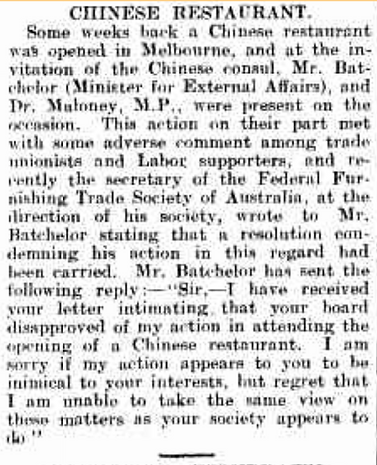
The History of Chinese Cuisine in Australia
"When there is more than one Chinese family in a city, you will inevitably find a Chinese restaurant in the vicinity."
- Doreen Yen Hung Feng in The Joy of Chinese Cooking, 1970.
Late 1800s
The late nineteenth-century was categorised by the introduction of 'cookhouses' or 'cookshops', or small restaurants that served gold miners. The majority of Chinese immigrants to Australia were from provinces that spoke Cantonese, and ate Cantonese food - as a result, the fish, pork, poultry, and rice that characterises the Cantonese style of cooking flooded Australia's menus and restaurants and exacerbated in their customers an insatiable appetite for more.

The first Chinese restaurant in Australia was opened at Bakery Hill, Ballarat in 1854, by Chin Thum Lok, also known as John Alloo.
1900s
The early twentieth-century was characterised by racial tensions and an anti-immigrant sentiment. It was one that was born from the competition between European and Chinese gold miners, which continued into labour-related work. The importation of Chinese labourers willing to work for lower wages was common in the late nineteenth-century, and had resulted in unionists in the working class to protest with militancy. A key example was the Seafarer's Strike of 1879, where labourers went on strike to protest the sacking of European workers in favour for Chinese workers. The racism facing Chinese immigrants throughout this time can be seen in a short newspaper clipping from 1910, where a politician, Egerton Lee Batchelor, is criticised by trade unionists for dining at the opening of a Chinese restaurant.
Read more about the Seafarer's Strike of 1878-1879...

A newspaper clipping from the Riverine Herald, Victoria, 2nd August, 1910.
The early twentieth-century was also characterised by the introduction of the Immigration Restriction Act of 1901, resulting in those left to work in the country being without their families. The exemption in this legislation was that businesses were allowed to employ overseas workers and bring them into the country without having to pass the problematic Dictation Test. The exemption became a loophole used to bring family members into the country. An example can be found with the employment of Louey Fat, in the Canton Tower Café in Bourke Street that opened in 1925. The full story can be read in the article after clicking the link below.

Louey Fat, a chef at the Canton Tower Café, 1949.
2000s
The late nineteenth and early twenty-first century were subject to a societal shift, with a rising number of immigrants being brought into the country to settle. The growing number of Chinese-Australians, whether born in China or Australia, were responsible for the growth in the number of Chinese restaurants. Nowadays, there are Chinese restaurants in every major city, and Chinese cuisine is well-known and enjoyed by many individuals from many different cultures.

The Marigold, a yum-cha restaurant established in 1982, but closed permanently due to COVID-19.

Happy's Restaurant, established in 1962, owned by the same family for generations.

Vinh Phat, the first yum-cha restaurant in Cabramatta, established in 1985.
